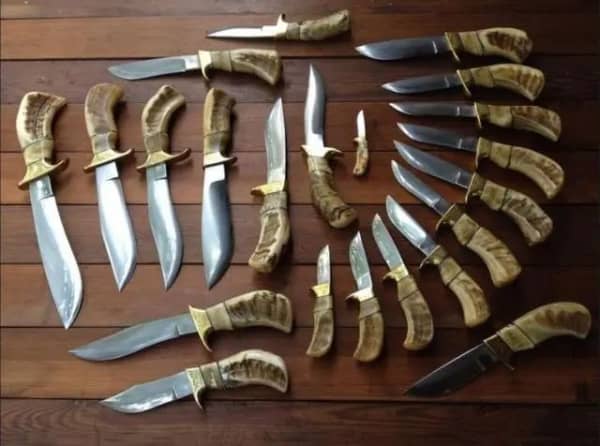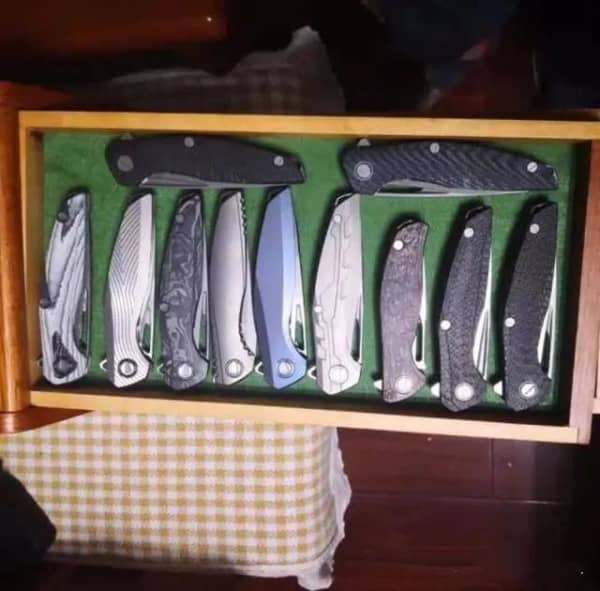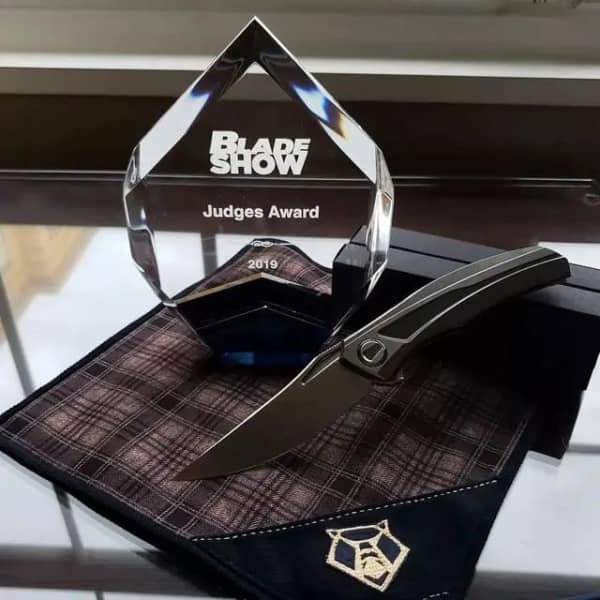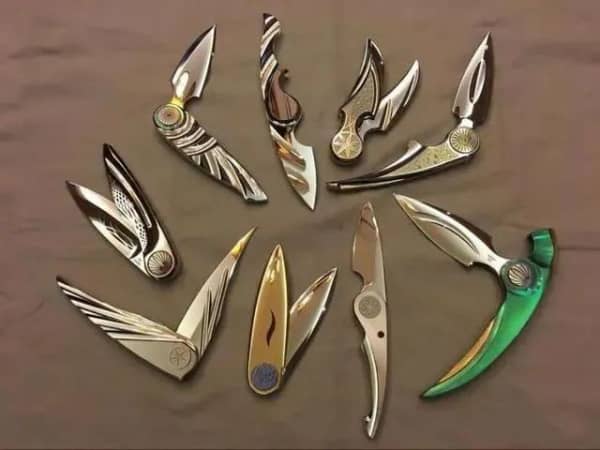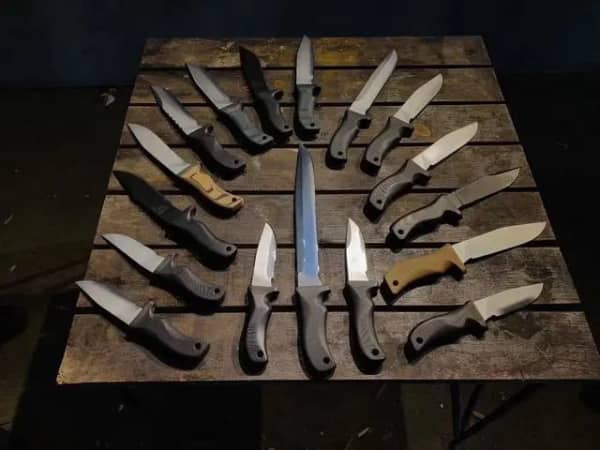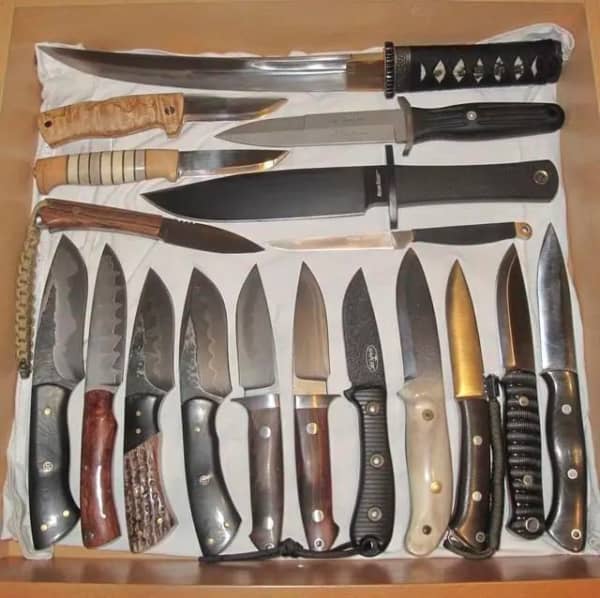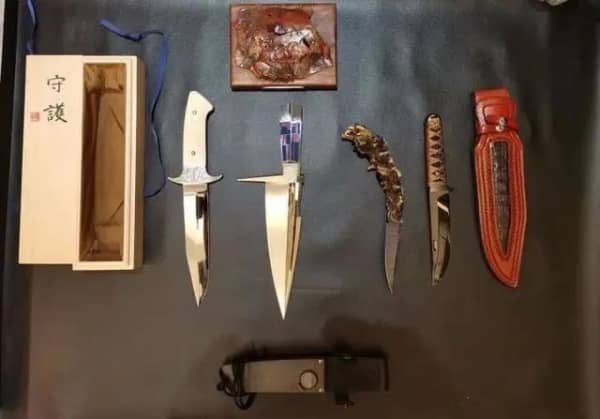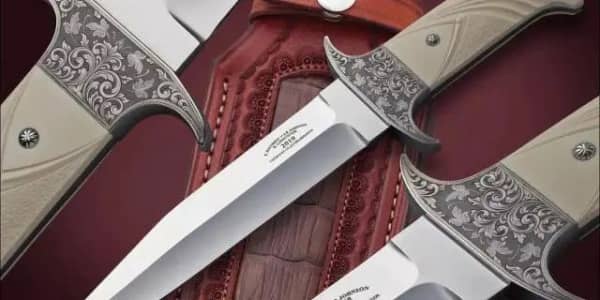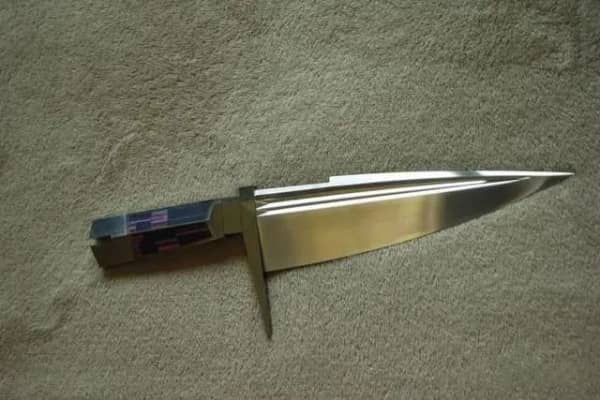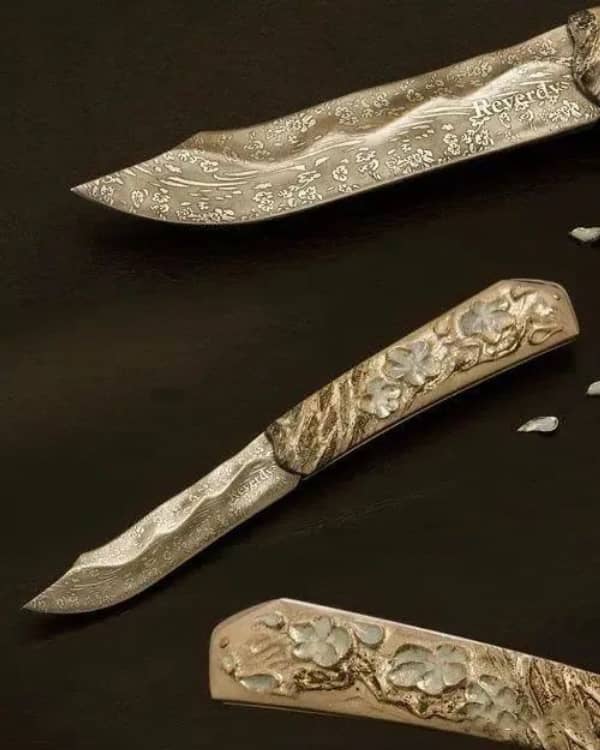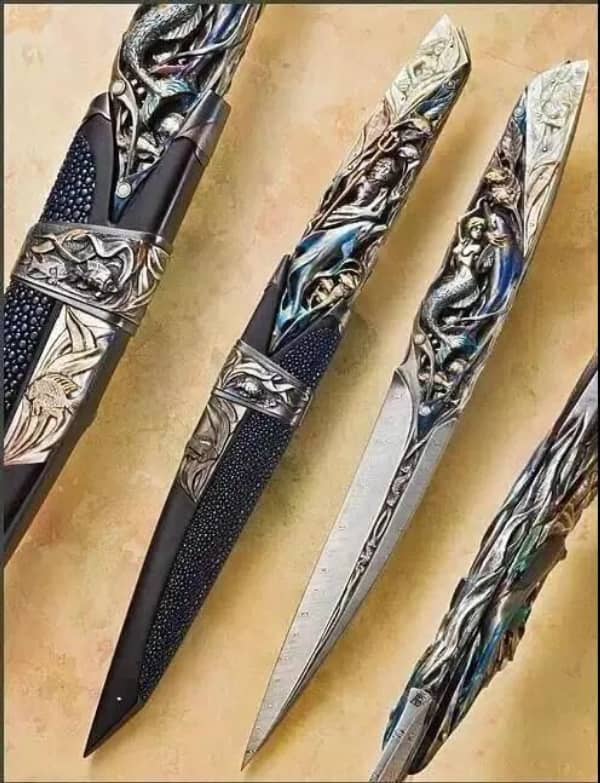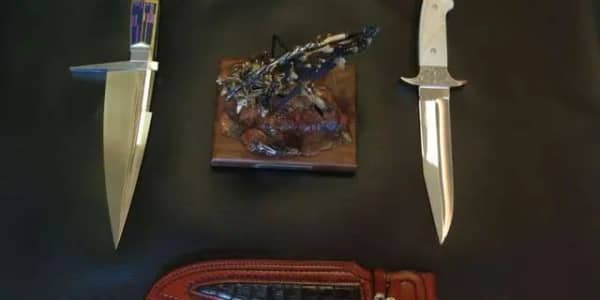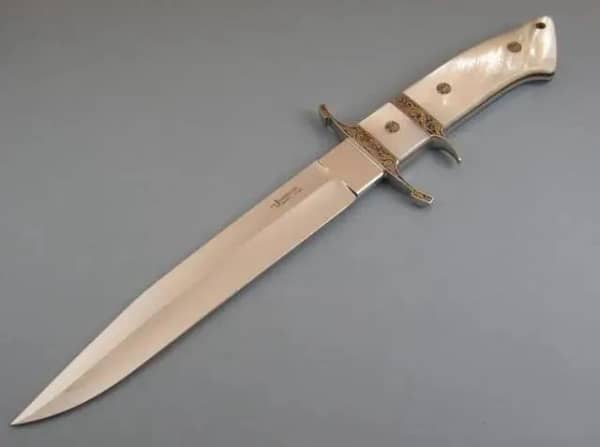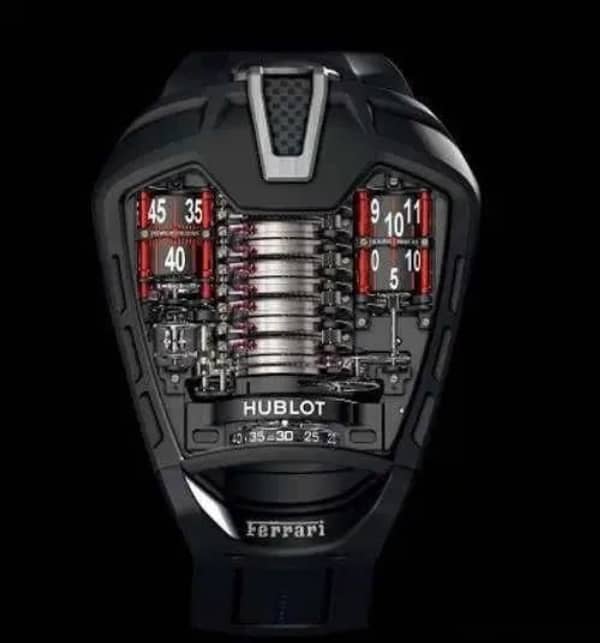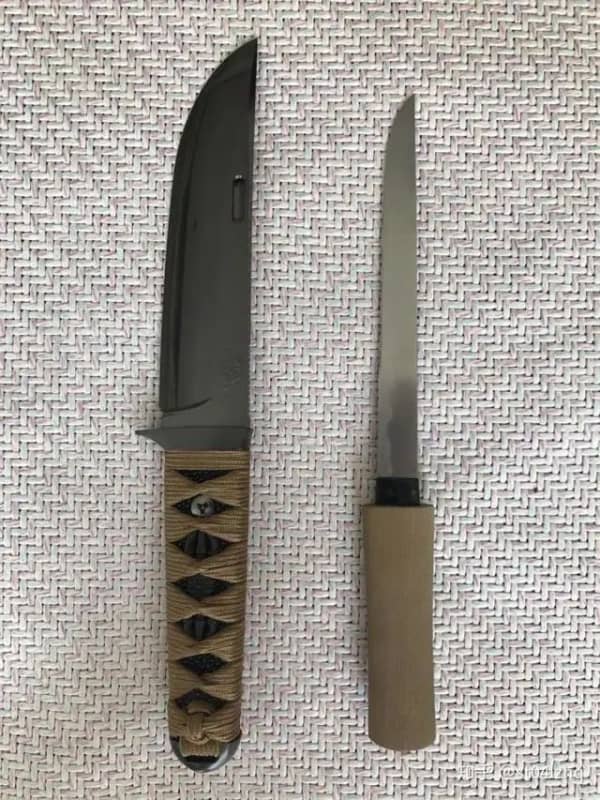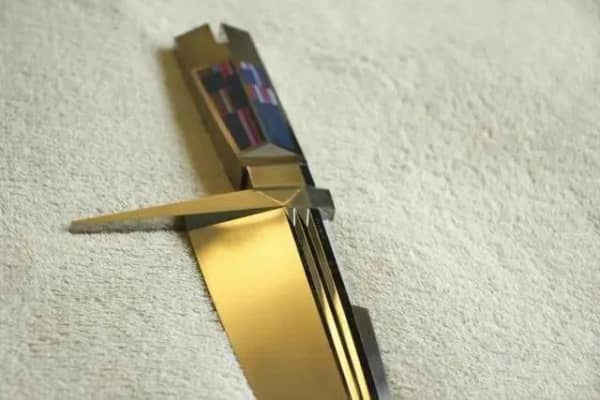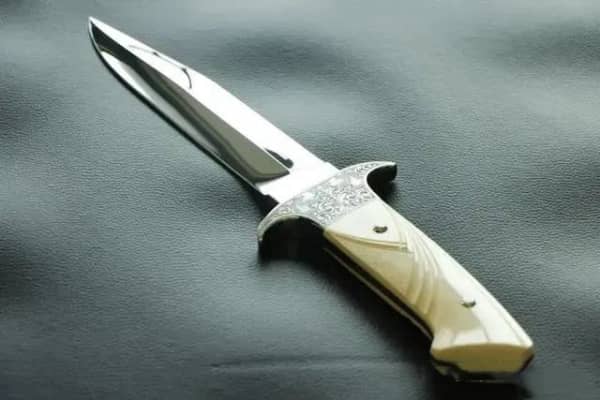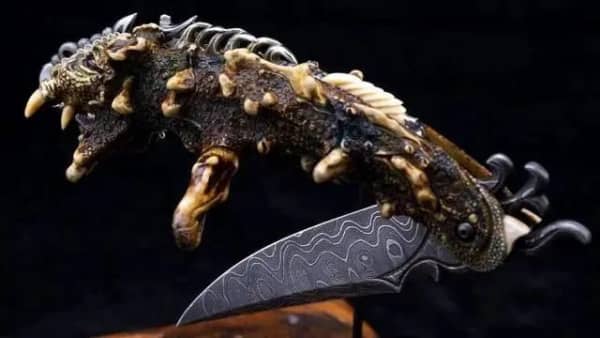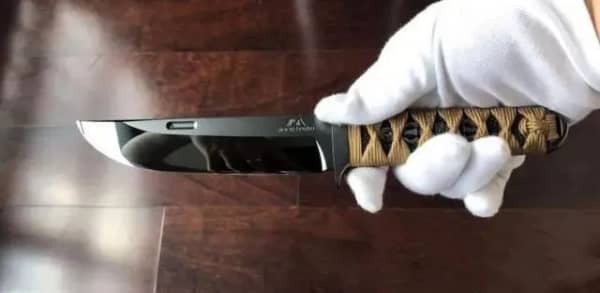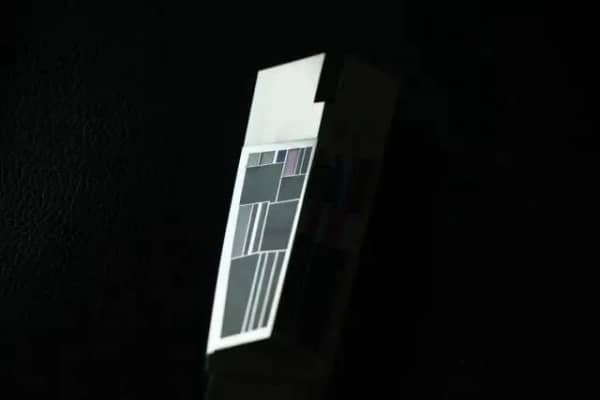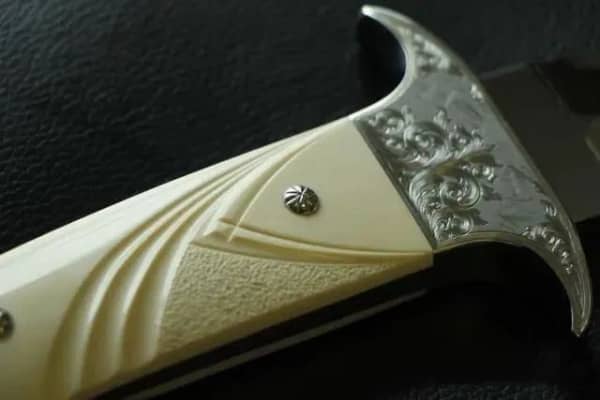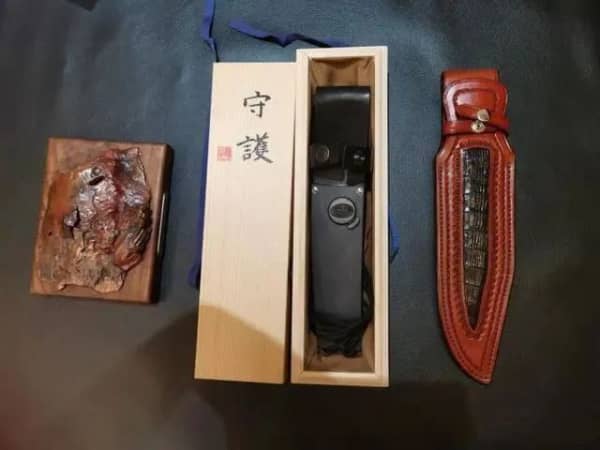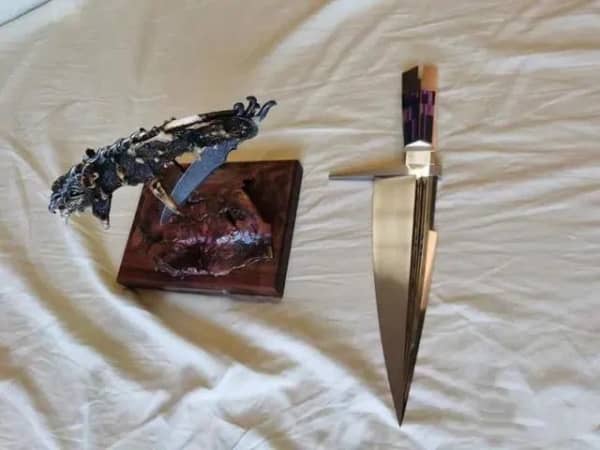Collecting knives requires ideas, attitudes, and actions to be able to have fun and play for a long time. That is to say, you must have a certain cultural accumulation and appreciation ability, as well as a certain economic strength, in order to feel the fun. There are generally two directions for collecting knives. One is to collect them in sets and series, and the other is to collect them with the tip, which is eclectic.
Buy everything you like at home—a collection of complete sets and systems
The happiest thing in the world is to buy all the things you like at home. When you are obsessed with an author, you can’t wait to collect all his series of works. This is a kind of appreciation for friends.
The collection of complete sets and systems is to collect all the works of a swordsmith in different periods and types, or to collect a certain type of sword (such as a big sword) from many different swordsmiths. See the picture: This is a foreign collector Collection of works by Edward Fuller, known as the Sword God.
Knife God Edward Fowler Works
Known as the God of Swords, ABS MS knifemaker Edward Fowler, after more than 30 years of research and more than $70,000 in experiments, the grain of 52100 steel has reached the test standard 15 and finer grain refinement. In the past, it was believed that the grain size of 10 was the theoretical limit of 52100 steel (this accuracy is said to have reached or even exceeded the fineness of Uzi steel). With his own power, he processed the fine particles of ordinary carbon steel to a level that is difficult for a national laboratory. You are not a god.
The combination of fine grain and blade geometry made us think it was a great knife, he said. While the price may seem high, each knife has over 52 hours of operation and over 50 years of research put into it. They have an absolute guarantee that if you think you paid a lot of money or want your money back for any reason, just return the knife and you will be refunded, not if you used the knife or not.
His operation on 52100 carbon steel is absolutely a fairy level.
He is a firm believer that there is no better knife than a properly forged, hardened and tempered steel blade that he knows well. I have recommended his knives before, maybe domestic friends are not too interested in this shape and material, and the price is more expensive than Mad Dog. However, if you know something about his miraculous heat treatment, when you know that this is an unprecedented work, and when you know that his knife performance is so powerful, maybe you will become his confidant, Foreign collectors have good eyesight. This kind of rare and non-replicable works bears Fowler’s unique spirit and skills, and his works are rare and worthy of collection. I really envy that collector, there are so many of Fleur’s works.
This is just a small part of the collection of bear head pocket knives
There are also many collectors of Russian bear heads. That kind of smooth opening and closing, that kind of precise scale can make people feel beautiful. People who like Bear Head are all in love with its attitude of excellence and simple and clear design.
The shape of the Xiongtou knife is wide and thick, with a full and comfortable grip. With a knife in hand, even weak women and children will have an indescribable sense of security, let alone a man. Equipped with a Xiongtou, the heart immediately Full of arrogance and ambition, he has the great ambition of “Though there are tens of thousands of people, I will go”.
Xiongtou Knife is not only unique in design, but also has worked hard on product details. Highly fine workmanship permeates every link, and the appearance of its blade and handle is perfect to the extreme; edge cutting, centering, geometric grinding, locking details And so on, its uniformity and quality control have blown away all competitors in the industry, and the choice of positioning beads is also ingenious, even as small as a screw, it is also exquisite to the extreme. It is said that a certain Chinese local tyrant bought a bear head for more than $1000 at the Atlanta Knife Show in the United States.
God-level collection! A top Master of Art knives that only makes one or two a year – A collection of Apu’s works
Don’t underestimate these small knives, this can already be called a god-level collection. It is hard to imagine how much energy this collector has spent on the collection of works of the top master of art knives, Apu, who only makes one or two a year. Looking at these works, you can feel the collector’s love for Apu, as well as the cherishment and love for beautiful things.
The mad dog knife made by rocket engineer Kevin McLane has fans all over the world. This is part of the collection displayed by a domestic collector. What does a knife bring to people? It is a sense of security. When you hold a mad dog knife, your heart is immediately filled with arrogance and ambition, and you have the ambition of “Though there are thousands of people, I will go there”.
January 2020 Kevin McClung with his grandson
Regardless of its ugly appearance, Mad Dog is actually a 100% handmade knife. All the knives are made by Kevin McLane himself. Dumping, not to mention the grip feeling like growing in the hand. I have experienced a lot of mad dog knives, and the attraction it releases seems to be a call from ancient times. I advise against experiencing Mad Dog yourself, you can’t help but fall in love with it. Except for the real mad dog, all imitation mad dogs on the market will not give you this feeling. This is the manifestation of strength, irreplaceable, and appropriately rare. I even think that Mad Dog can be used as an equivalent of global circulation, because fans are distributed in various countries and regions.
What I said above is the practice of complete sets and series collections. The requirements of this kind of gameplay are very high, and the financial resources and energy required are far beyond that of ordinary collectors. Only the real masters in the circle will take this route. These masters often have very high discrimination and organizational skills. They are a group of thoughtful, knowledgeable, and actionable people, and they are undoubted social elites. That’s the conclusion I’ve come to from trading with some of them.
Carefully choose, pinch and collect – eclectic collection
Try not to collect too many works of the same kind, and it is enough to find a representative collection. Try to expand the coverage of different regions, different styles, and different materials in your collection.
Objectively speaking, the first systematic way of playing is the kingly way of collecting, but it consumes too much money and energy, and it is beyond the reach of ordinary people. The second way of playing is more suitable for most players who have limited investment and just want to appreciate the essence of as many swordsmith works as possible.
Some people may have doubts. Doesn’t eclecticism mean that each knife maker only accepts one representative work? Then make a list and arrange them one by one according to the budget? What else do you think? This statement is wrong. There are so many swordsmiths and so many works. If you aimlessly and see one after another, not to mention spending money, you may not achieve the desired effect in the end. My experience is that there must be a framework for the eclectic gameplay. First build the overall framework, and then gradually add bricks and tiles to it, and spread the branches and leaves. In this way, in the early stage of collection, you can spend little money or collect few works. Appreciate the purpose of different styles!
It is most appropriate to use a binary tree fractal diagram to explain what the collection frame is. The shape of the “Y” at the bottom is the frame. Each fork continues to be subdivided, and the collection system will be gradually and orderly improved.
So how should this framework be built? I give two principles for your reference:
Orthogonality: There must be sufficient distinction between works. Works with similar styles are not suitable for collection frames. For example, the fork at the root of the binary tree in the above picture is the largest, and the difference becomes smaller as you go to the end.
Completeness: The style and characteristics of framed works should cover as wide as possible. For example, if you want to appreciate the style of handmade knives in different countries, it is not complete if you only use the works of European knife makers as the frame. You should at least choose some American and Asian ones. work.
Simply talking about the concept is still empty. And in recent years, there has been a bad trend in the circle, thinking that if you have not owned something yourself, or at least played with it, you are not qualified to express your opinion. I do not fully agree with this point of view, after all, everyone has the right to express themselves. However, in order to prevent human flesh ETC, I still use my collection as an example to talk about this topic, which will be more convincing, please see the picture below:
These are a few representative ones in my collection, which together form the cornerstone of the collection system
From left to right, the four works are:
- “The end of the six emperors” cooperative knife (the joint creation of six emperors in the knife world can make your collection of art knives come to an end in advance. For more details, please read my article. This may be the best art knife in the collection. Cooperative work “Introducing a collaboration that may be the best in the field of modern collection art knives”)
Cooperative work of 6 top masters loveless cub
- Jurgen large kitchen knife, high-end style, top-level difficulty inlay. For more information, please read the article “Where is Jurgen, who is known as Picasso in the knife world?”
- The Fulgen Warcraft Goblin Jackknife is covered with honey juice particles, which stimulates the senses at its peak. “Diaosi’s Counterattack! Blacksmiths with red necks also have artistic geniuses——appreciation and analysis of Larry Fulgan’s works”.
- Hanada Hiroshi’s best work, luck. Because the value and the difficulty of collecting are not high, I am too lazy to write articles. In fact, it is my favorite one.
Please forgive me and ignore my secondary description of the above four works. Since I will rewrite this article after two years, it is naturally because I am satisfied with my collection. Although there are not many things, they are very different, and they barely meet the previous principles of orthogonality and completeness. Next, I will start from several dimensions and share with you my thoughts on building a collection framework.
Dimensions of knife collection
Dimension 1. Region: Europe, America, Asia
Knife is one of the basic tools of human society, and its production is universal, so the work itself will to some extent carry the national cultural characteristics of its production region. Please note that this is universal in the world. There are many handmade collections whose origin is generally limited to one country or even a certain city, such as Jingdezhen porcelain, so it is impossible to make horizontal comparisons across countries or even across continents.
Looking at these few, if they are divided by place of origin, they just include Europe, the United States, and Asia, the three major continents of the world. If it is specific to the country, it is the three major industrial countries of Germany, the United States and Japan. And I think these works largely represent regional characteristics:
Jürgen, place of origin: Europe – Germany Features: artistic heritage, innovative breakthroughs
In the field of Western art, Europe is obviously a well-deserved holy place if you look at it in terms of continents. From ancient Greece and Rome to later Italy and France, it was once the center of world art at that time. The artistic background accumulated over thousands of years can be well displayed even in the field of practical tools such as knives. The works of European knife makers are generally stronger, bolder and more breakthrough in artistic expression.
Poetic Damascus – Works of Pierre, a top French knife maker
The top works of Eastern European art knife master Arpad
The top work of Eastern European art knife master Arpad: Mermaid. It just happens to be a pair with the one in the hands of a high school student collector in China.
So Jurgen is obviously a representative of artistry and breakthrough innovation among European knife makers. The style of geometry + mosaic color blocks is his first, which is quite different from others. He himself also said: “I rarely look at other people’s knives, worrying that it will affect my own creation.” I will not expand the details here.
Cooperative knife, place of origin: America – America Features: a balance between practicality and art, complete industrial system
The level of photography is too limited to live up to this knife
The two continents of the Americas are very different from Europe and Asia. Its native civilization was forcibly interrupted by foreign colonists and lost its inheritance, but correspondingly its new civilization got rid of the shackles of history and was able to travel lightly, thus bursting out more Strong and exuberant vitality. This cultural characteristic is fully reflected in modern knives.
Taking American knives as an example, the most classic types of knives, including loveless fighting knife/beagle, dog bone boi, southwestern boi, etc., basically have a very good balance between practicality and appreciation. For example, the loveless-style big bear below, mirror polished + engraved + precious handle material, in addition to jewelry-level delicacy, it can also maintain an excellent grip, which is really rare.
Loveless style work, sculpture collaboration between Johnson and Lindsay
God-level loveless style work, Johnson + Lindsay carving, super large mother-of-pearl patch.
Another example is the works of the ABS line. Although the Malaysian forging patterns have been extremely fancy in recent years, they still have a good performance in practical aspects, and the performance of the Malaysian forging works has become the standard for ABS MS qualification assessment.
Royer’s Malaysia has indeed become more and more complex and fancy in recent years, and the works have gone further and further on the road of exquisiteness and gorgeousness, but the performance is still quite good, and they will be tested during the production process.
So we found that although there is still a big gap between the artistic breakthrough of American knives and European knives, most of the works of American knife makers come and go with only a few classic styles, but you must know that such things as artistic breakthroughs are controversial. Not everyone can accept and understand the risks and risks. American knife makers have chosen some classic knife shapes that are more in line with the public’s aesthetics. The wind develops, caters to the tastes of most people, and earns enough money. The influence of the American knife circle is second to none in the modern knife circle. The current very popular tactical TKI is also American).
In addition, the American knife circle is also very good at cooperation. In most cases, the division of labor for knife making, carving, sheath making, and heat treatment is clear, and the upstream and downstream systems of the industrial chain are complete. As the saying goes, everyone earns money. The collaborative work of six masters in my collection is a very typical case (I won’t expand here, if you are interested, you can read my article, the link is in front of it).
Huatianyang straight knife, place of origin: Asia – Japan Features: Adhere to the tradition, take the edge of the sword.
I have always had a feeling for Japanese products: they are stubborn and rigid at the macro level, bound by the traditional framework and do not know how to adapt, but at the micro level, they are brainstorming and strive for excellence. It is the so-called strategic laziness and tactical diligence.
To give an example of their inflexibility, everyone knows “Detective Conan”. In the animation of hundreds of thousands of episodes, although the modus operandi has changed to some extent, the plot of each episode is basically travel-encounter-murder-suspect People N choose 1-anesthetized Kogoro-solve the case-the prisoner’s confession. There is nothing new in the fixed template, and both the audience and the author seem to be completely accustomed to this routine, staying in their respective comfort zones and unwilling to break through.
Their innovations at the micro level are often slanted and not accepted by the mainstream. For example, the Japanese Grand Seiko watch, known as the Oriental Rolex, is designed in a very traditional style in the 1950s and 1960s, which is very different from the imaginative designs of brands such as Richard Mille, Hublot, and HTY. inside.
This is a watch designed to mimic the engine of a sports car
Although the style is old, the Japanese invented the Spring Drive technology, which is a technology that uses the mechanical energy of the rudder to generate electricity, and the electric energy drives the movement of the pointer. In the field of mechanical watches, it has achieved ultra-high precision within 1 second per day. A lot of Swiss brands. It is undeniable that this technology is remarkable in terms of innovation. It has both the beauty of a mechanical movement and the precision of a quartz movement. However, this mechanical + electronic composite movement solution is not accepted by mainstream bezels. The practical school thinks that no matter how accurate it is, it cannot compare with an electronic watch, while the play school thinks that the electronic components in the movement are not pure enough.
The Japanese are like this. If you don’t open your mind, you can easily go astray. It’s like walking and encountering a wall, Europeans will detour, Chinese will turn over, Americans will break the wall, Japanese will hit the wall, after confirming that they can’t get through, they will start to study and shrink themselves to be able to A way to pass through gaps in walls.
Speaking of the Japanese brain hole, I suddenly remembered a past event. In a university class many years ago, the teacher talked about the current research direction of invisibility clothing in various countries. Most of them are through the research and development of new materials, changing the refractive index of materials to custom light diffraction realize invisibility. However, Japan’s research direction is very different. They are committed to researching display technology, if they can wear a display screen on their body, and then install a camera to project the scene behind them on the display screen in front of them. This brain hole surprised me at the time, and the Japanese’s swords are slanted.
Well, let’s go back to the knife. On this Hanada Yangzhi knife, the ancient tradition and modern technology are integrated into one, which perfectly embodies the contradictory characteristics of the Japanese.
Let me talk about the traditional method first. The style is traditional, and the basic shape of the Japanese-style short knife has remained unchanged for thousands of years; the handle is traditional, wrapped in shark skin, and the silk thread is wound according to the traditional method, a typical Japanese-style handle roll. The structure is traditional, the blade and the handle are detachable, and fixed by the eye, which is consistent with the structure of the samurai sword. The overall design has a strong sense of antique, with few innovations and breakthroughs.
The real traditional Japanese knives are not out of harmony.
But in terms of the performance and sharpening of the knife, Hiroshi Hanada has achieved the ultimate. Ten years ago, the application of “Kobelco” like M390 on knives was far less popular than it is today. At that time, Hanada Yang processed ZDP189, a high-end powder steel, to an ultra-high hardness of more than 67 (general knives were around 55, to 60 Already a very high level of hardness), there is also a higher-end HAP72 steel, the hardness is even close to 70! It’s kind of shocking. The sharpening of the clam blade of the knife is also very good, the opening edge is very small, and the edge line is so thin that it is almost invisible. The sharpness of the factory can draw circles on A4 paper or cut off the corners of the entire dictionary page with one knife. Not to mention semi-production, even if you compare all the handmade knives and mass-produced knives, in terms of the appearance and performance of the clam blade, it is almost unmatched.
At that time, Hanada’s chief engineer, Mr. Hanada, every time he participated in the knife exhibition, because of his average English level, he didn’t take the initiative to communicate with others, so he just cut bamboo with a knife, cut hemp rope, tossed hundreds of times and then cut it. The paper was still as sharp as before, and the audience was shocked.
However, this kind of super high hardness and super cutting performance, in my opinion, is like the Japanese’s consistent problems. It belongs to the type of slanting swords. It is relatively “stupid” and lacks consideration. Say a few questions:
Blindly pursuing ultra-high hardness, it is too brittle in actual use, and it is more prone to chipping after chopping. If you only do cutting, the retention is super strong, but no matter how strong it is, it will still decrease and become blunt. It is extremely difficult to regrind if the hardness is too high.
I like to use aluminum alloy for tool handles. The super-strong blade material is matched with such a handle material. The overall strength is seriously affected, and it is not practical.
The round hole on the knife destroys the overall aesthetics (in fact, I don’t think it matters, but some knife lovers can’t accept it). It is said that it is a fixed hole designed for better grinding of clam blades by CNC. Grinding the clam blade is not a super-difficult grinding technique, it can also be done by hand. Is it necessary to make such a hole? Can you lower your standards a little? Hanada Hiroshi is not, in order to pursue the ultimate sharpness, he will not hesitate to give up the beauty. In my opinion, it is a bit like the practice of piercing the ceiling because there is not enough light in the room.
Some people will say that the knives at the price of Hua Tianyang are not practical in the first place, and those impractical problems have no effect at all. Yes, the truth is like this, but since it is not for practical purposes, why should it be sold with practical indicators such as performance, sharpness, and hardness? Isn’t it contradictory? In contrast, Jurgen from Germany is much freer and easier, and believes that collection and display are the main functions of his works, so some knives have no opening at all.
Seeing this, from the analysis of a knife, do you have some understanding of the contradictory personality of the Japanese? The book “The Chrysanthemum and the Sword” said it well: “The Japanese are aggressive and gentle, martial and very beautiful, rough and very polite, rigid and very flexible, meek and very rebellious, noble and very vulgar and brave. Timid, conservative and enthusiastic about new things”
From the design and production of knives, we can also see the cultural characteristics of different countries and regions. It is very interesting. From the situation reflected in my few collections, European knife craftsmen are creative and energetic literary youths, while American knife craftsmen He is an ordinary young man who is exquisite and considerate in every aspect, while the Japanese swordsmith is a 2B youth who seems to be dull and honest but is extremely sullen in his heart (there is no meaning of praise here).
I strongly recommend collectors of eclectic genres to build frameworks according to regions. You must know that in the field of collecting knives today, American knives are the most influential and widely used in the market. Although the system of American knives is also very complicated, from the perspective of complete In terms of gender and diversity, if funds and energy allow, it is a very good choice to try to collect some works of European swordsmiths or even modern Japanese swordsmiths to appreciate a different style. In addition, the traditional Japanese samurai swords are more different from the modern handmade swords I mentioned. They already belong to the category of ancient soldiers. Expand again.
Dimension 2: Surface treatment technology: brushed – mirror – Malaysian pickling – coating
Steel is a very amazing material. Different surface treatments have very different visual effects. It is very interesting to compare the differences between them. Coincidentally, these four knives all use completely different surface treatments:
- Jurgen, multi-plane drawing with different meshes + facet mirror surface
Hand-drawing, especially high-mesh hand-drawing, I think is one of the most difficult surface treatment techniques. This treatment method can well show the texture of the metal and highlight the sharpness of the knife. Jurgen’s big kitchen knife is very masochistic in most of the planes, including the blade, handguard, and handle, which are all brushed, and there are differences in the number of meshes, ranging from 800-1200-1500-2000.
- Cooperative knife, one-piece steel with full mirror polishing
The dense structure of steel determines that the effect of polishing and polishing is far better than materials such as wood and stone. If the wire drawing can fully reflect the “rigid” side of the knife, then the mirror surface can show the “soft” side. Proper handling mirror effect is like mercury leaking.
- Forgan goblins, pickled
It is very different from wire drawing and mirror surface. Pickling is a chemical treatment method. Different metal materials will be oxidized and corroded to different degrees after pickling, and then form the Damascus pattern we see.
Although the big horse pattern of Fulgan’s goblin is not coquettish enough, it fits the artistic theme very well.
- Hanada Hiroun, DLC coating
Different from the first three surface treatment technologies, DLC coating is a rare surface treatment technology in the field of collecting knives, and it is difficult for the knife maker to handle it by himself. It is too wasteful to have a set of special coating equipment for making knives. However, from the perspective of visual effect, it is very good. Firstly, the smoothness of the mirror surface is much higher than that of the handmade mirror surface. It is difficult to find any scratches or uneven places. Secondly, the coating will be colored black and purple. The black blade like this Hanada Yang after coating adds a bit of stern beauty.
Dimension 3, decorative techniques inlaying, flat coiled thread carving, three-dimensional antler carving
Knives in the collection field often like to add some decorations to improve visual beauty and added value. The decoration techniques of these knives are also very different. It is worth mentioning that Jurgen, Barry Lee, and Fulgen are the strongest among them in the field of inlay and engraving within the scope of knives! It is lucky to be able to appreciate the skills of top masters:
- Jurgen kitchen knife, Youshi inlay
European knife makers, including several AKI masters such as Jurgen, Antonio, and Emmanuel, especially like inlaying on knives. I have analyzed before that perhaps the technique of inlaying is easier for a knifemaker to complete alone, and does not rely on collaborators. Better express the artistic theme of knives.
- Collaborative Knife, Barry Lee Burning Carving
The article I wrote on the cooperative knife analyzed in detail the exquisite carvings of Barry Lee, the world’s first gold carving master. Said Barry Lee’s signature stunt – burning and carving.
- Fulgrim Goblin, Carved Antlers
Among the knife makers in the world today, Fulgen is among those who can carve natural materials such as antlers and teeth to perfection. (Forge combines the skills of forging, knife making, carving, and sheath making, and is a veritable almighty king)
Dimension 4, scabbard: no sheath, leather sheath, wooden sheath, base sheath
A player I admire on the Internet posted pictures of some scabbards from his collection one day. At that time, I was quite shocked when I saw them. They have different styles and ingenuity, and the things worth pondering seem to be no less than the knives themselves. So you can see that the hobby of playing with knives is really happy, not only the main body, but also the peripheral accessories are of great play value.
I had a whim to see if there was anything worthy of consideration and comparison in the scabbards of these works, and I was surprised to find that they were quite different from each other.
Jurgen is without a sheath. I can’t think of any suitable sheath for this epoch-making pioneering work unless it is a base like Fulgan Goblin?
The scabbard of the cooperation knife is sewn by Paul Long, the world’s first sheath master. What is rare is that this sheath incorporates the design of the loveless scabbard into the consistent Paul Long style. It is reminiscent of the design of the cooperation knife body that was born out of loveless, I can’t help but admire the old beauty’s comprehensive consideration of issues, which is much better than the single-minded brains of the Japanese.
Hua Tianyang’s scabbard has two parts, one is a synthetic material scabbard that looks close to wood, and it also has their original locking mechanism, full of sense of technology; the other is a wooden box with the word “Guardian” written in handwriting on it, is obviously a tribute to the traditional samurai sword culture. You see, this sense of contradiction between tradition and technology reappears on the scabbard. The Japanese really like to contradict themselves (in fact, I suspect it is intentional, just to create this kind of conflict between tradition and modernity. atmosphere).
Forgan’s “scabbard” is a display base, and it seems that it can’t be called a sheath at all, but in a broad sense, as an accessory of the knife body, something with a certain load-bearing function is not too much to be used as a scabbard. This base is made of wood and copper, with full texture, and the atmosphere of the scene is very effective. It is not a blow to say that Fulgrim is omnipotent.
Dimension 5. Art style: figurative and abstract
I feel more and more lucky about myself. I didn’t expect to find two diametrically opposite artistic styles in this collection framework, which I didn’t consider at all when I first collected them. And even more fortunately, they are both at the top of their respective artistic styles in the field of collectible knives.
Fulgan Goblin is extremely concrete. The sores and scars on the surface of the monster, the posture of the mane, the corrosion at the root of the fangs, and the food residue on the inner wall of the mouth are all displayed in a very specific and vivid way.
Jurgen is extremely abstract. The blade, guard, and handle are all in one geometric structure, almost all of which are straight lines and planes; the handles are inlaid with windows of various quadrilaterals and rectangles; the color of the inlay material is also mainly a single color.
For readability, I list a table below:
A common ground:
Remember the title of this article? Eclectic, compare similarities and differences. “Different” is there, but where is the “same”? In fact, if you don’t put the four knives together to find common ground, I would say that they are all works of members of the AKI Association (however, Hiroshi Hanada doesn’t count). After much deliberation, I finally found one:
They all maintain or have reached the peak level in one or more specific fields.
Jurgen is the pinnacle of the abstract art of knives, Fulgen is the pinnacle of the figurative art of forging knives, cooperation knives are the pinnacle of flat gold carving art, and Hiroshi Hanada is the pinnacle of retention and sharpening.
Why do I put so much emphasis on peak performance? Because according to the eclectic gameplay, only one genre will be charged, and no more will be charged. If this work cannot reach the peak level in its category, it will be somewhat regrettable. Of course, this is my personal paranoid opinion.
Does striving for the top cost a lot of money? What should I do if I am unable to catch up? I will answer this question in several points:
Due to its niche and well-known environmental reasons, art knives are less affected by capital forces. The overall price system is compared with many other collections, such as clocks, jewelry, jade, purple sand, pipes, wood carvings, Wenwan, etc, there is still an order of magnitude difference. If the other collections are to reach their peak, the price is definitely not affordable for ordinary middle-class or even ordinary wealthy families. What’s more, I don’t think the production difficulty, scarcity, artistry, and preservation of art knife collections are not bad at all, and even sometimes they are even worse. In a word, there are relatively few hype elements, and it is relatively easy to reach the peak.
“Peak” can be self-proclaimed by you, or it can be dynamically changing. It is the peak according to your own knowledge, or the peak that your financial resources in collecting can reach. A long time ago, I thought that CR’s one-piece knife was the pinnacle of finish and design, and I was satisfied when I collected one.
“Peak” can be subdivided into fields. In theory, as long as it continues to be subdivided, every knife or every type of knife can reach its peak. For example, micro technology is the pinnacle of straight jumping, Kevin Casey’s works are the pinnacle of feathered Damascus, bear head mass-produced folding knives are the pinnacle of finish and assembly in the field of mass-produced pocketknives, and CR Sand is the simple design and finish of that era. The pinnacle of perfect match, Brazilian Julian is the pinnacle of Damascus forging precision among non-MS masters, and CAS is the pinnacle of cooperative works of brother knifesmiths. These examples I cited are not unattainable.
Where will it go next?
After the framework is set up, under normal circumstances, the next step should be to spread branches and leaves based on the framework and gradually improve it. There are too many things to improve. For example, although there are European swordsmith works, Europe is also divided into Western Europe, Northern Europe, and Eastern Europe. The styles of works in each region are also very different. Licio, Antonio, Emmanuel, and Pierre from France also have their own unique skills.
American knifesmiths are even more diverse in style, including grinding school and forging school. In the forging school, there are Seiko school like Royer, freehand school like Fisk and Cook, and pastoral school like ED. In addition, South American knife makers Such as Rodrigo, Frank, Julian and others have also sprung up in recent years. Also, if you collect according to the evolution of the entire modern knife, the works of American masters such as scagle, loveless, Moran, Kronk, and Buster are also not to be missed. It has been shortened due to the slightly lower grade of the work.
In Asia, although Japanese modern knives are generally not as good as those in Europe and the United States, Hirayama Harumi is still very interesting. If it is too expensive, you can also consider Mamuro, Suzuki Hiroshi and other loveless style successors, at least the workmanship will not disappoint. Even domestically, there are some knife makers whose level is getting higher and higher. I have ordered one myself, and I will share it with you when I have the opportunity.
This is a broad avenue. If you follow this way of thinking, the vast majority of fellows who embrace eclectic genres will definitely gain more, and become more and more satisfied with the collection, heading for a better tomorrow.
However, I am still a little unsatisfied. I still have the idea of rebuilding the frame.
What? Is this crazy? Isn’t the framework set up? Aren’t these thousands of words written about your own collection framework? Well written (forgive my immodestness), why rebuild?
Because I may be the most demanding, picky, and paranoid among the knife circle players. Of the four knives in the article, I have only one that is 100% pleasing to the eye and has no dead angles in 360 degrees, and it is the one that most people do not expect: Hanada Hiroun.
Surprised? It turned out to be Hua Tianyang whose value was far lower than the other three, not in the same order of magnitude at all. But please note, I said pleasing to the eye, what is pleasing to the eye?
Pleasing to the eye is the first and most important one in my best-written article “Seven Principles for Appreciating and Collecting Art Knives”: like it or not. It has nothing to do with factors such as author, grade, degree of completion, artistry, value preservation, etc. It is the first impression of the overall appearance of the tool to the viewer, which is too personal and mysterious to be analyzed.
Don’t I like the Jurgen large cleaver? I like it, otherwise I wouldn’t write so many articles. Its grade is already close to the pinnacle of all Jurgen’s works, and the inlay is definitely the pinnacle level. It is a new work, and there is no preservation of Jurgen’s old works. Phase problem, what else am I not satisfied with?
In terms of appearance, I think traces of traditional knife shapes can still be found in its geometric structure, but it is not enough in terms of avant-garde and breakthrough. I like the more exaggerated and eccentric Jurgen. It’s a pity that it is almost impossible to find it, and the works he will make in the future will most likely not meet my requirements in terms of appearance. It feels like there are only two, and they are designed in 1986.
In his whole life, maybe those two can meet my 360-degree appearance requirements without dead ends. Of course, this is my very personal point of view. Many Jurgen fans, on the contrary, prefer works such as large kitchen knives or Berlin subways that are closer to the shape of traditional knives. It’s my honey, that’s arsenic.
Collab Knife I don’t like it? Love it, but if it’s an impeccable big bear style, it’s perfect. Can you do it again with Johnson and Barry Lee? Difficult, but not impossible, but can you still find Wolfgang for handles and carvings? Find BOS to do heat treatment and marking by yourself? Johnson Barry and Li Daxiong still have several, but this level of cooperation knife is unique. What’s more, the level of sophistication and finish of the cooperative knife itself is the best among similar works I have seen, and the new custom-made works are more or less risky.
The most important reason is that Johnson, Barry, and Li Daxiong are too expensive, and people still have to do what they can. Therefore, although the cooperative knife does not meet my standard of 360 degrees without dead ends, I can’t find a better substitute, so I can completely give up.
Don’t I like Fulgan Goblins? I like it, but I have other favorites, but I can hardly find them.
It seems that my paranoia has determined that my real collection concept is:
Eclectic, but it must be my own favorite of the genre, and I couldn’t find a better one.
But life is always full of imperfections, maybe we will eventually reconcile with ourselves and compromise with life.
Click to have more Shieldon EDC knives and tools fun.

